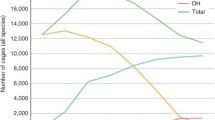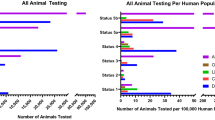Abstract
A rodent biosecurity program that includes periodic evaluation of procedures used in an institution's vivarium can be used to ensure that best practices are in place to prevent a microbial pathogen outbreak. As a result of an ongoing comprehensive biosecurity review within their North American and European production facilities, the authors developed a novel biosecurity auditing process and worksheet that could be useful in other animal care and use operations. The authors encourage other institutions to consider initiating similar audits of their biosecurity programs to protect the health of their laboratory animals.
Similar content being viewed by others
References
Institute for Laboratory Animal Research, National Research Council. Guide for the Care and Use of Laboratory Animals 8th edn 109 (National Academies Press, Washington, DC, 2011).
USDA APHIS Veterinary Services. NAHEMS Guidelines: Biosecurity (United States Department of Agriculture, Washington, DC, 2013). http://www.aphis.usda.gov/animal_health/emergency_management/downloads/ nahems_guidelines/fadprep_nahems_guidelines_biosecurity.pdf.
Food and Agriculture Organization of the United Nations. Biosecurity in Food and Agriculture. Committee on Agriculture, Seventeenth Session. Rome, Italy, 31 March–4 April 2003. http://www.fao.org/biosecurity.
Baker, D.G. Natural Pathogens of Laboratory Animals: Their Effects on Research Ch. 2 (ASM Press, Washington, DC, 2003).
Fox, J.G. et al. (eds.) Laboratory Animal Medicine 2nd edn (Academic, San Diego, CA, 2002).
Committee on Infectious Diseases of Mice and Rats, Institute of Laboratory Animal Resources, Commission on Life Sciences, National Research Council. Infectious Disease of Mice and Rats (National Academies Press, Washington DC, 1991).
Venkatesan, P.S. Biosecurity in the laboratory animal facility. ALN World 4, 8–13 (2010).
McEntee, H.I. & Sandgren, E.P. A tool for semiannual review of the institutional animal care and use program. Lab Anim. (NY) 36, 36–40 (2007).
Avian Biosecurity Advisory Council. National Avian On-Farm Biosecurity Standard (Canadian Food Inspection Agency, Office of Animal Biosecurity, Ottawa, Canada, 2009). http://www.inspection.gc.ca/english/anima/biosec/aviafrme.shtml.
Chin, R.P. et al. Intervention strategies for laryngotracheitis: impact of extended downtime and enhanced biosecurity auditing. Avian Dis. 53, 574–577 (2009).
Author information
Authors and Affiliations
Corresponding author
Ethics declarations
Competing interests
The authors declare no competing financial interests.
Rights and permissions
About this article
Cite this article
Porter, W., Horn, M., Cooper, D. et al. Auditing laboratory rodent biosecurity programs. Lab Anim 42, 427–431 (2013). https://doi.org/10.1038/laban.409
Received:
Accepted:
Published:
Issue Date:
DOI: https://doi.org/10.1038/laban.409
- Springer Nature America, Inc.




